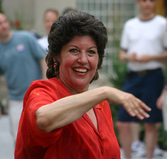Carol Schwartz bids to become the education mayor

Photo by David on Flickr.
Carol Schwartz has produced a detailed, thoughtful platform on a key issue in the DC mayoral race, education. It’s unlikely to be enough to propel her long-shot campaign to victory, but right now her position is the one most likely to ensure stability in DC Public Schools.
Schwartz, a former at-large DC Councilmember, has some good ideas about things like lessening the focus on standardized tests and retaining veteran teachers. Her 15-page white paper is a far more comprehensive document than anything produced by either of the other candidates, and her positions align better with those of DC Public Schools Chancellor Kaya Henderson.
Schwartz also has more education experience than her rivals, Councilmembers Muriel Bowser and David Catania. She first came to DC to teach special education, inspired by the experience of caring for her intellectually disabled brother. She went on to serve two terms on the now-defunct Board of Education, which governed DC’s public schools (not to be confused with the current State Board of Education, which does not). And her three children all attended DCPS.
Schwartz’s stances on hot-button issues like school boundaries and charter school growth suggest that a Mayor Schwartz would have a better chance of retaining the current DCPS Chancellor than either a Mayor Catania or a Mayor Bowser.
How important is that? It’s true that the pace of progress under Henderson has been slow. And some DCPS policies, like the system for evaluating teachers, could certainly be improved. But it will be unfortunate if the mayoral election results in Henderson’s departure.
Henderson is a smart and competent administrator who has demonstrated an admirable willingness to try new initiatives, some of which may be on the verge of bearing fruit. It would be a shame if those processes were disrupted and the pace of change slowed further, or possibly even reversed.
With those considerations in mind, some DC education activists have thrown their support to Bowser rather than Catania, despite Catania’s greater expertise on education. As chair of the DC Council’s education committee, Catania has acquired a detailed knowledge of the public school landscape, and he’s brimming with ideas about how to improve it. Bowser’s strategy on education, on the other hand, has basically been to say as little about it as possible.
But Catania and Henderson have had a testy relationship, and he hasn’t said whether he would keep her on. It’s not clear she would stay under a Mayor Catania even if he wanted her to.
Bowser, on the other hand, has said she’d like Henderson to stay, and she’s been generally complimentary about the Chancellor’s performance.
Bowser’s opposition to new boundaries
But Bowser’s recent statements on the controversial boundary plan adopted by Mayor Vincent Gray may have soured that cordial relationship. Henderson supports the plan, and Bowser, like Catania, recently came out in opposition to it.
What’s more, for some reason Bowser added that she didn’t anticipate involving the DCPS chancellor in formulating a substitute proposal.
As Gray observed, that doesn’t seem like a wise move. Henderson wasn’t in charge of the recent boundary process, but she was certainly involved. And that seems only appropriate for a process involving the boundaries and feeder patterns of the system she heads.
Not only is the move unwise substantively, but Bowser’s remark seems bound to alienate Henderson. While the Chancellor hasn’t said anything publicly about these developments, it’s possible she’ll decide that Bowser isn’t someone she actually wants to work under.
Schwartz, for her part, seems to have struck all the right notes for retaining Henderson. Schwartz commits to allowing her to stay on for “the time she has stated she wants, which is one or so more years.” (Henderson has said she’d like to stay until 2017.) And in one of a series of veiled digs at Catania, Schwartz says she would not “micromanage” a chancellor but rather would “partner with” her “in setting policy and goals.”
Schwartz on school boundaries and charters
On the crucial issue of school boundaries, Schwartz suggests a few tweaks, such as increasing the percentage of set-asides for out-of-boundary students to maintain diversity. But she says she accepts the need for change.
She also sides with Henderson on some issues that have emerged recently in the relationship between DCPS and the charter sector, such as joint planning between the sectors. While charter advocates are amenable to joint planning that is voluntary on their part, it’s clear that Schwartz believes it would make sense to impose limits on such things as where new charter schools can open.
Charter advocates have resisted that as an infringement on their autonomy. But Henderson and others have argued, with some justification, that without those kinds of limits, charter expansion could easily undermine plans to improve DCPS schools.
Will any of this convince DC education reformers who want Henderson to stay on to switch their support from Bowser to Schwartz? Probably not, given the overwhelming odds against Schwartz. But perhaps they can urge Bowser to do whatever she can to mend the damage she may have done to her relationship with Henderson.
Beyond that, Bowser might want to flesh out her own skimpy education platform with some of the ideas that abound in Schwartz’s white paper. Schwartz may never get a chance to implement those ideas herself, but it would be nice if someone did.
